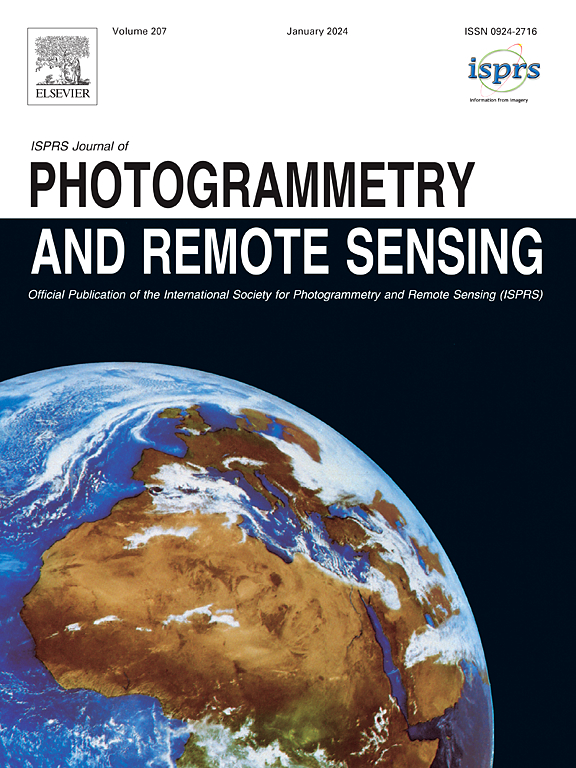From rice planting area mapping to rice agricultural system mapping: A holistic remote sensing framework for understanding China's complex rice systems
IF 10.6
1区 地球科学
Q1 GEOGRAPHY, PHYSICAL
ISPRS Journal of Photogrammetry and Remote Sensing
Pub Date : 2025-04-19
DOI:10.1016/j.isprsjprs.2025.03.026
引用次数: 0
Abstract
Information on the rice agricultural system, including not only planting area but also phenology and cropping intensity, is critical for advancing our understanding of food and water security, methane emissions, carbon and nitrogen cycles, and avian influenza transmission. However, existing efforts primarily focus on mapping planting area and lack a comprehensive picture of the rice agricultural system. To address this gap, we propose a remote sensing-based comprehensive framework for mapping the rice agricultural system in China: First, we identified valid growth cycles of crop by using 30-m Sentinel-2 and Landsat fused data; Second, we applied a well-established phenology-based algorithm to map rice planting areas, by extracting the flooding and rapid growth signals in the transplanting and rapid growth temporal windows; Third, the rice-specific phenology phases (i.e., transplanting, tillering, heading, and mature) were identified using a phenology extraction method tailored to the physiological characteristics of rice; Finally, rice cropping intensity was determined based on detailed phenological phases and planting area data. Due to the accurate identification of crop cycles and pixel-level temporal windows at the national scale, the generated rice planting area maps exhibit a high accuracy across China, with both overall accuracy and F1 scores exceeding 0.8, based on validation with over 13,000 field samples. Improvements in the extraction method have addressed the lag in phenology detection caused by rice’s flooded environment, leading to more accurate phenological information. As a result, the phenological data shows reliable accuracy (R2 of 0.6–0.8 and RMSE of 8–15 days), facilitated by the mutual enhancement of rice planting area and phenology mapping. The resultant rice phenology and cropping intensity maps are the first of their kind with 30 m resolution. Together, the resultant rice planting area, rice phenology, and cropping intensity maps provide, for the first time, a comprehensive picture of China's rice agricultural system, better supporting multiple targets related to Sustainable Development Goals.
从水稻种植面积制图到水稻农业系统制图:了解中国复杂水稻系统的整体遥感框架
有关水稻农业系统的信息,不仅包括种植面积,还包括物候学和种植密度,对于增进我们对粮食和水安全、甲烷排放、碳和氮循环以及禽流感传播的了解至关重要。然而,现有工作主要侧重于绘制种植面积图,缺乏对水稻农业系统的全面了解。针对这一不足,我们提出了一个基于遥感技术的中国水稻农业系统综合绘图框架:首先,我们利用 30 米 Sentinel-2 和 Landsat 融合数据确定了作物的有效生长周期;其次,通过提取插秧和快速生长时间窗口中的淹水和快速生长信号,我们应用了一种成熟的基于物候学的算法来绘制水稻种植面积图;第三,利用针对水稻生理特点的物候学提取方法确定了水稻特有的物候期(即插秧期、分蘖期、扬花期和成熟期);最后,根据详细的物候期和种植面积数据确定了水稻种植强度。由于在全国范围内准确识别了作物周期和像素级时间窗口,生成的水稻种植面积图在全国范围内表现出较高的准确性,根据对超过 13,000 个田间样本的验证,总体准确性和 F1 分数均超过 0.8。提取方法的改进解决了水稻淹没环境造成的物候检测滞后问题,从而获得了更准确的物候信息。因此,在水稻种植面积和物候绘图相互促进的作用下,物候数据显示出可靠的准确性(R2 为 0.6-0.8 和 RMSE 为 8-15 天)。由此绘制的水稻物候和种植密度图是首张 30 米分辨率的水稻物候和种植密度图。所绘制的水稻种植面积图、水稻物候图和种植密度图首次全面反映了中国的水稻农业系统,为可持续发展目标的多个相关目标提供了更好的支持。
本文章由计算机程序翻译,如有差异,请以英文原文为准。
求助全文
约1分钟内获得全文
求助全文
来源期刊

ISPRS Journal of Photogrammetry and Remote Sensing
工程技术-成像科学与照相技术
CiteScore
21.00
自引率
6.30%
发文量
273
审稿时长
40 days
期刊介绍:
The ISPRS Journal of Photogrammetry and Remote Sensing (P&RS) serves as the official journal of the International Society for Photogrammetry and Remote Sensing (ISPRS). It acts as a platform for scientists and professionals worldwide who are involved in various disciplines that utilize photogrammetry, remote sensing, spatial information systems, computer vision, and related fields. The journal aims to facilitate communication and dissemination of advancements in these disciplines, while also acting as a comprehensive source of reference and archive.
P&RS endeavors to publish high-quality, peer-reviewed research papers that are preferably original and have not been published before. These papers can cover scientific/research, technological development, or application/practical aspects. Additionally, the journal welcomes papers that are based on presentations from ISPRS meetings, as long as they are considered significant contributions to the aforementioned fields.
In particular, P&RS encourages the submission of papers that are of broad scientific interest, showcase innovative applications (especially in emerging fields), have an interdisciplinary focus, discuss topics that have received limited attention in P&RS or related journals, or explore new directions in scientific or professional realms. It is preferred that theoretical papers include practical applications, while papers focusing on systems and applications should include a theoretical background.
 求助内容:
求助内容: 应助结果提醒方式:
应助结果提醒方式:


